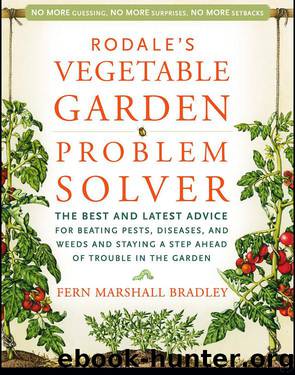Rodale's Vegetable Garden Problem Solver by Fern Marshall Bradley

Author:Fern Marshall Bradley
Language: eng
Format: epub
ISBN: 9781594863080
Publisher: Rodale
Published: 2009-03-03T05:00:00+00:00
A rainy period followed by heat and humidity can also lead to a sudden onset of late blight. If the weather turns dry after symptoms appear, they may stop spreading. But it’s a temporary reprieve, and the disease will intensify again as soon as rain returns.
The fungus survives winter in potato tubers, living crop debris, and sometimes as resting spores in the soil. Late blight shows up in a spotty fashion. One year it may devastate your garden but next year not appear at all. Or it may infect tomato plants in your garden but not in your neighbor’s garden.
RANGE: United States; southern Canada (humid regions only)
CROPS AT RISK: Tomatoes and potatoes
DESCRIPTION: Leaves develop greasy-looking or water-soaked spots. In moist conditions the spots enlarge rapidly, turning brown or purplish black. Shoots blacken and plants sometimes collapse quickly. White moldy growth sometimes appears. Rotting plant parts give off an unpleasant odor. Potato tubers show purplish or brown corky spots. Tomato fruits show grayish green water-soaked areas. These spots enlarge and turn dark. Often, secondary rot sets in on both potato tubers and tomato fruits, and they turn mushy and foul-smelling.
FIGHTING INFECTION: Check for symptoms at least every other day when the weather is wet. Remove infected plants from the garden immediately. Even if symptoms show only on a few leaves, uproot the whole plant or plants, place the plant material in a plastic bag, and seal it. Remove the bag from the garden and put it with household trash for disposal (or bury the plants deeply in soil well away from your vegetable garden). Afterward, change your clothing and wash your hands before you return to the garden—spores on your clothes or hands could infect other plants. Hill potato plants to stop spores from washing down to the tubers.
If potato crops show symptoms as harvest time approaches, remove all potato foliage from your garden and then wait at least 2 weeks before you dig the tubers. Wait for dry conditions to dig tubers, and be sure to remove all tubers from the soil. Check all harvested tubers for spots and don’t put spotty ones in storage. Spray foliage with compost tea.
GARDEN CLEANUP: If late blight appeared at all in your garden, clear out all tomato and potato crop debris at the end of the season and burn it or bag it for disposal.
NEXT TIME YOU PLANT: For future crops, improve soil drainage. Choose certified disease-free seed potato varieties that are resistant or tolerant. For tomatoes, choose resistant varieties if you can—not many are available. Keep your tomato plants dry at all times by sheltering them under a clear-plastic tent (open at the sides). Water only at soil level. Clean your tools every time before working around susceptible plants. If you can’t shelter plants from rain, use preventive sprays of compost tea or Bacillus subtilis, but note that these sprays are not always effective against late blight. Copper sprays also protect against infection, but repeated and thorough sprays are required.
CROP ROTATION: In
Download
This site does not store any files on its server. We only index and link to content provided by other sites. Please contact the content providers to delete copyright contents if any and email us, we'll remove relevant links or contents immediately.
Turbulence by E. J. Noyes(7942)
The Thirst by Nesbo Jo(6832)
Gerald's Game by Stephen King(4584)
Be in a Treehouse by Pete Nelson(3954)
Marijuana Grower's Handbook by Ed Rosenthal(3623)
The Sprouting Book by Ann Wigmore(3546)
The Red Files by Lee Winter(3368)
The Remains of the Day by Kazuo Ishiguro(3296)
Sharp Objects: A Novel by Gillian Flynn(2958)
Christian (The Protectors Book 1) by L. Ann Marie(2656)
Organic Mushroom Farming and Mycoremediation by Tradd Cotter(2631)
The Culinary Herbal by Susan Belsinger(2433)
Stone Building by Kevin Gardner(2353)
The Starter Garden Handbook by Alice Mary Alvrez(2285)
Lilac Girls by Martha Hall Kelly(2258)
The Unlikely Pilgrimage of Harold Fry by Rachel Joyce(2222)
The Lean Farm Guide to Growing Vegetables: More In-Depth Lean Techniques for Efficient Organic Production by Ben Hartman(2099)
Urban Farming by Thomas Fox(2063)
Backyard Woodland by Josh VanBrakle(1895)
